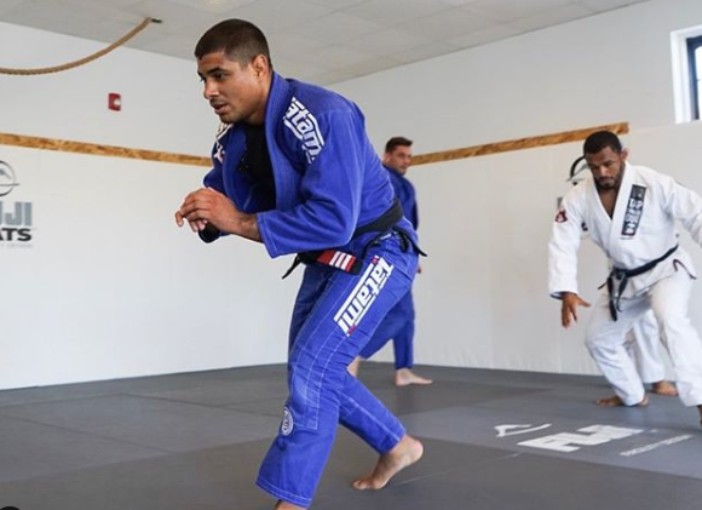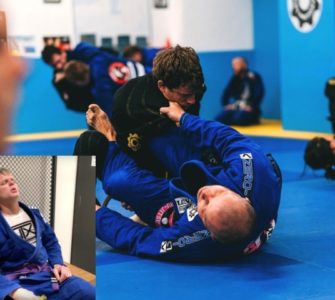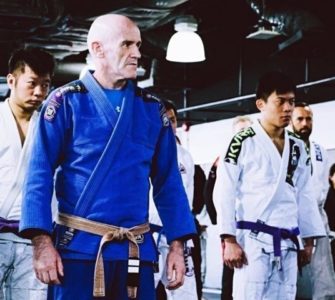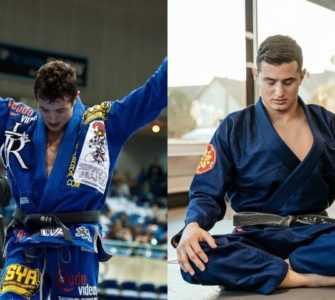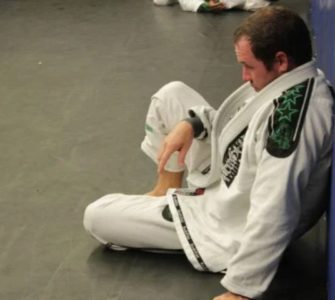He is one of today’s most exciting lightweight grapplers – an athlete whose technique finesse and entertaining style have brought him to becoming a number one not just for many fans of the gentle art; but to becoming a champion with many accomplishments both before and after getting promoted to black belt as well.
Jonathan „JT“ Torres has already left an important legacy on a contemporary grappling scene, and will continue to do so in the upcoming years. We sat down with him and listened to what he had to say about his BJJ beginnings, his story on getting promoted to blue belt by Royce Gracie, how he developed notoriously strong grips and his advice on finishing the bow and arrow choke.
Enjoy!
BJJEE: Thank you very much for being a part of our interview Jonathan, it is a pleasure. You are one of the contemporary all-time greats in Jiu Jitsu, with many titles behind you.
But, if you weren’t doing BJJ in the first place – if it wasn’t a career of yours – what do you think you’d be doing instead?
JT Torres: If I wasn’t doing Jiu Jitsu, if I wasn’t in love with BJJ the way that I am today, I think that I would be doing one of two things. Either I would be skateboarding professionally – that’s something that I’ve always loved and enjoyed. Or I would be in something that comes with it, like the sneaker world and fashion… So, if I wasn’t skateboarding, I would be probably designing sneakers and be running my own clothing company or something like that.
BJJEE: So, skateboarding was your love before Jiu Jitsu?
JT Torres: Yes. As a child, one of my first loves was skateboarding. I was into skateboarding for many years, but then I discovered BJJ. And I got very serious with it, because I loved it right off the start.
BJJEE: And how did it all start with Jiu Jitsu?
JT Torres: For me, it all started when I was a kid and my parents enrolled me into karate school. In this karate school, my sensei was a blue belt in Jiu Jitsu under Royce Gracie as well, and he used to teach one Jiu Jitsu class a week; whereas the other classes were karate and stuff like that.
So, what I used to do was that I used to take regular karate classes. But my sensei would always teach a little bit of BJJ in them, just a little bit. So, I always had a little bit of an insight into what Jiu Jitsu was.
I remember that when I received my black belt in karate – I was fourteen years old and I was getting ready to go to high school – that I didn’t want to continue with karate in high school. I thought that it wasn’t cool or a „good look“ to be doing it (laughs). And, honestly, I kind of wasn’t into it anymore. And my dad was like: „Why don’t you find a way to stay in shape?“ And I wanted to try out for the basketball team in high school – and in the trials I got cut out, I didn’t make it into the team… I was too short, I never had the height on my side.
So, that was when I decided that I would go back and give this Jiu Jitsu thing a chance, perhaps just once a week.
And when I did the class, I really enjoyed it, I loved that it was hands-on. In karate, I was just throwing punches and kicks while looking in the mirror; and in BJJ, I was grappling with another person. I was thinking a lot more. That’s what I really enjoyed about it and what made me fall in love with it.
I remember when I hit my first submission – I believe that it was the triangle – and when I locked it in and the person tapped, I was like: „Wow, this is crazy!“ The way that I can use my body to submit someone else and make them tap and hold them down… I said that I wanted to learn more, that this is the real deal stuff, stuff that actually works.
And I’m not saying that karate doesn’t work; of course, if you punch or kick someone in the head, then it will definitely work. I just thought that Jiu Jitsu was a lot more interesting.
Once I got that first submission, I fell in love with it.
BJJEE: And so off you were on your way to great accomplishments! Do you have any favorite memories from the early days on the mats?
JT Torres: Well, one of my favorite memories from my early days of Jiu Jitsu was when I was promoted to a blue belt. That was in karate school, at one of Royce Gracie’s seminars. Royce Gracie has come to hold a seminar and I remember that he was watching me roll after the seminar was over. Then, he rolled with me and after the round was done, he said: „You know what? I think that it’s time for you to take the next step.“ And then he took out a blue belt and promoted me.
I don’t remember if Royce Gracie himself remembers promoting me to blue belt, but that was huge for me.
For, I remember watching this guy fight in the UFC… And I mean, even to this day, he’s a legend. He’s one of the pioneers of the sport. So, to get promoted to blue belt by him was crazy! I remember the feeling of just seeing that blue belt tied around my waist… I felt almost as if it was a black belt. That is one of my favorite memories from early on.
BJJEE: Wow, that one must’ve felt exhilarating! And what about your more recent, adult competition days? Is there a particular medal or a tournament that is really special to you?
JT Torres: I would say that the medal that holds a special place in my heart is my ADCC gold medal from 2017.
I mean, I have many titles, many great titles… Many memories within those medals. But I always say that the 2017 ADCC gold medal is the one which is very close to my heart. Because, after I’ve won that title, I felt that I’ve solidified my name in the history books as one of the greatest to ever do it. It was a dream and a goal that I realized on that day.
I remember that, when I first started doing Jiu Jitsu and when I fell in love with it, I’ve written down some goals for myself: that I wanted to become a world champion, that I wanted to get my black belt, that I wanted to open up my own academy. And accomplishing my ADCC gold medal was a way to check off an important thing off the list.
BJJEE: So, we’d guess that the ADCC competition podium is the one you prefer the most?
JT Torres: Yes, my favorite podium has to be the ADCC podium. That’s just because it’s on a grand scheme; you know all of the fighters there and it is truly the best of the best competing there.
BJJEE: Great! Would you then say that you prefer training in No Gi rather than the Gi?
JT Torres: Actually, when it comes to training Gi or No Gi, I really don’t have a favorite – I enjoy both pretty equally. And I’ve always done both since I’ve started training… I’ve never done only Gi or only No Gi – I’ve always done both, since I’ve started.
Even when I competed, as a kid and as a white and blue belt, I’d always sign up for NAGA’s and Grappler’s Quest in both Gi and No Gi.
So, it wasn’t any different to me. I feel that only in recent years it became a big thing that some people train only in Gi and other only in No Gi. To me, that seemed so strange because, well, I’ve always done both, from the very beginning. It was something that I’ve always done and something that I continue to do up until this day.
During the day, I train without the Gi; during the night, I train with the Gi on. I enjoy both.
BJJEE: So, there are disadvantages of training exclusively in the Gi or No Gi?
JT Torres: If I had to mention advantages or disadvantages, I’d say that the person that trains both has an advantage simply because they have a different perspective on grappling… That you can only get if you do both.
BJJEE: And your proficiency in both well documents that perspective! What’s more, your Gi skillset is made up of an additional aspect – your grips, which are said to be unusually strong.
How was it that you’ve developed this sort of grip strength?
JT Torres: A lot of people say that my grip strength is very strong, and for that I give all the credit to my dad (laughs). When I was in my teenage years, around 15 or 16 years old, he was living in an apartment in which he took a rope and attached it to the ceiling.
The ceiling wasn’t very high, but I’d climb that rope all the time. I would start off my butt, climb all the way up, go all the way down until my butt hit the floor – and then I’d climb all the way up again.
It wasn’t a really thick rope, but a thin one. I think that climbing on a thicker rope is actually easier, because on a thin rope you really have to squeeze your hands tight so you don’t slip down.
So, that rope in my dad’s apartment – which is still hanging till this day – is something that has definitely helped my grip strength to become what it is today. And that is exactly what I’d recommend to someone looking to build their grip strength; climb rope. I don’t think that there’s anything better than climbing rope, in my opinion.
BJJEE: We guess that a lot of jiujiteiros will start climbing rope now that they’ve read this. 🙂
What about your favorite submission? Do you have one and what piece of advice would you give to someone who wants to execute it better?
JT Torres: I’m going to have to say that my favorite submission is the bow and arrow. I love the bow and arrow choke and that’s because, in my opinion – if done right – it’s really hard for a person to escape it.
One detail that I teach my students all the time and that I’ll share with you guys is this one: when you go for the bow and arrow and after you’ve hooked the leg, you always want to make sure that you fall towards your hip that’s facing your partner’s legs. If you fall flat on your butt or flat on your back, or you fall towards your head, then there’s actually an opportunity for them to escape.
Whereas, if you fall towards your hip that’s facing their legs, you make it into such an angle that it’s very difficult for them to turn either way. Whether they try to go to the left or right, they’re simply going to go deeper into the choke.
And another piece of advice is hooking the leg. Hook the leg, don’t make the grip outside of the pants. Actually hook the leg, like a fishhook, and then fall on your hip that’s facing your opponent’s legs.
You’re going to have a much higher finishing rate with these two details.
BJJEE: Great advice on the bow and arrow, thank you for sharing it! On the other hand, do you have some sorts of advice in regards to activities outside the mats, that would improve someone’s BJJ? Do you do anything outside of Jiu Jitsu that you think greatly improves your game?
JT Torres: Yes, something I do engage in my Jiu Jitsu practice… Or, more specifically, after my strength and conditioning workouts is stretching. My strength and conditioning coach, John Marsh – he actually won the master World’s earlier this year – he has opened my eyes to stretching.
It helps with recovery and it helps with just keeping you healthy and not injured. Stretching is key. If there’s something that I could advise to everyone who’s reading this and who’s looking to improve their Jiu Jitsu, I would say that is stretching after working out. And even during Jiu Jitsu, it’s super important.
It’s going to help you recover, it’s going to help those muscles to continue feeling good and to avoid injury. I highly recommend it.
BJJEE: Absolutely… It is too easy to neglect stretching, especially after a long and exhausting training session, but it is really important. Thank you for sharing that with us.
As we’ve come to an end of our interview, would you like to share anything else with our readers before we conclude?
JT Torres: One last thing I’d like to share with the readers is that hard work works. There’s nothing that you can do to replace hard work if you want to accomplish anything in life, on and off the mats. You’re going to have to work hard for it.
BJJEE: Beautiful. Thank you very much for your time, Jonathan. It has been our pleasure.
JT Torres: Thank you so much guys, I appreciate it.

